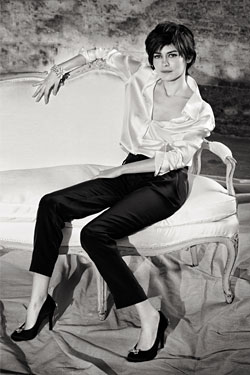Cuckoo for Coco
As a designer, Coco Chanel became synonymous with modernity. She also jumped into bed with the Third Reich. Audrey Tautou, the latest actress to play her, explains why Chanel’s legend is as enduring as a quilted handbag.
 |
All clothes and makeup by Chanel, available at Chanel Boutique, 15 E. 57th St., nr. 5th Ave. (212-355-5050).
(Photo: Max Vadukul/Courtesy of Chanel)
|
The pants are masculine, yes, but slung low on Tautou’s narrow hips they look very comfortable—and, perhaps because Tautou is the tiniest, prettiest gamine in a nation known for its tiny, pretty gamines, they also look great.
But would these pants exist if Coco Chanel had not? Would the striped jerseys that hang in the window of a fishing-supply shop across the street seem so alluring? Would the global vocabulary for glamour be anywhere near what it is today?
Tautou is the star of Coco Before Chanel, which opens next month. The film deals with the generally sad and muddy years of the designer’s life, well before she lived in her very own suite at the Ritz. It starts with her unceremonious dumping at a gloomy orphanage run by moonfaced nuns in elaborate hats, and then winds through her years as a seamstress and half-assed showgirl, and then we watch as she becomes entangled in morally complicated relationships with a few wealthy men who facilitate her early career as a maker of hats. There was Étienne Balsan, who offered her a room in his incredibly grand house, and, later, Boy Capel, thought to have been a great love of Chanel’s, who handily provided the dough for her very first shop.
The choice of Tautou to play Chanel is not an immediately obvious one (even if she does star in the brand’s current ad campaign). She looks more like a doll than a doll, as if she were dreamed up by the French tourist board. Tautou is most famous in America for playing Amélie, a bighearted pixie who spends her time sprinkling adorable love dust around her arrondissement, but the actress fell hard for Coco. “I think she’s the most brilliant woman I have ever played,” she says. “Definitely the toughest, and very complex.”
Tautou has dabbled in Hollywood—she plays Agent Sophie Neveu in The Da Vinci Code—but her heart is very much in France, where she’s a major movie star. “If I go to Los Angeles, it is only for a few days, to do interviews at the Four Seasons Hotel,” she says, laughing. And then she goes home. When she wraps up in Sète, she plans to take a vacation (it is, after all, August), and then head to Paris, to look for something on the stage.
Chanel was not a kind or an adorable or a particularly well-loved woman. She was, to put it mildly, the anti-Amélie. And it sometimes seemed that her main objective in designing was to point out that anyone wearing the lavish, feathered fashions of the day was basically kind of dim. “She was very severe to women, to people in general,” Tautou says. “You could even say she was misogyne.”
The world had been tough to Chanel, and Chanel was tough right back. It was a lot of work being Coco, even more so in the overwrought and seriously constricting clothes of turn-of-the-century France. “They were like a little jail,” Tautou says, crossing her tiny legs up into her chair. “You don’t breathe; you can’t move. I think she wanted so much to have the same freedom as a man, and the only thing she could start with was the freedom of movement.” Her clothes offered that, although the film suggests that this was not a grand feminist gesture, as one might anticipate from one of the first women to establish her own eponymous Parisian house, but rather a personal vendetta for something like equality, as if the wearing of trousers and tweeds could somehow lessen the humiliation of her dependence on men.
Chanel’s relationship to France was complicated: She found the success she was desperate for, and with it financial independence, but then had an affair with a Nazi officer during the occupation of Paris, which, among other things, allowed her to stay ensconced at the Ritz in the middle of the city’s worst moment. After the war, she was reviled in France and went into self-imposed exile in Switzerland. She stopped designing for a while. When she returned to France in 1954, her clothes were better received by Americans than Parisians. The French spared her one punishment for so-called collaboratrices horizontales—head shaving—but they were still reluctant to forgive.
评论
发表评论